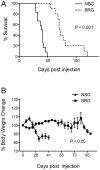Xenogeneic graft-versus-host-disease in NOD-scid IL-2Rγnull mice display a T-effector memory phenotype
- PMID: 22937164
- PMCID: PMC3429415
- DOI: 10.1371/journal.pone.0044219
Xenogeneic graft-versus-host-disease in NOD-scid IL-2Rγnull mice display a T-effector memory phenotype
Abstract
The occurrence of Graft-versus-Host Disease (GvHD) is a prevalent and potentially lethal complication that develops following hematopoietic stem cell transplantation. Humanized mouse models of xenogeneic-GvHD based upon immunodeficient strains injected with human peripheral blood mononuclear cells (PBMC; "Hu-PBMC mice") are important tools to study human immune function in vivo. The recent introduction of targeted deletions at the interleukin-2 common gamma chain (IL-2Rγ(null)), notably the NOD-scid IL-2Rγ(null) (NSG) and BALB/c-Rag2(null) IL-2Rγ(null) (BRG) mice, has led to improved human cell engraftment. Despite their widespread use, a comprehensive characterisation of engraftment and GvHD development in the Hu-PBMC NSG and BRG models has never been performed in parallel. We compared engrafted human lymphocyte populations in the peripheral blood, spleens, lymph nodes and bone marrow of these mice. Kinetics of engraftment differed between the two strains, in particular a significantly faster expansion of the human CD45(+) compartment and higher engraftment levels of CD3(+) T-cells were observed in NSG mice, which may explain the faster rate of GvHD development in this model. The pathogenesis of human GvHD involves anti-host effector cell reactivity and cutaneous tissue infiltration. Despite this, the presence of T-cell subsets and tissue homing markers has only recently been characterised in the peripheral blood of patients and has never been properly defined in Hu-PBMC models of GvHD. Engrafted human cells in NSG mice shows a prevalence of tissue homing cells with a T-effector memory (T(EM)) phenotype and high levels of cutaneous lymphocyte antigen (CLA) expression. Characterization of Hu-PBMC mice provides a strong preclinical platform for the application of novel immunotherapies targeting T(EM)-cell driven GvHD.
Conflict of interest statement
Figures







References
-
- Champlin R, Ho W, Gajewski J, Feig S, Burnison M, et al. (1990) Selective depletion of CD8+ T lymphocytes for prevention of graft-versus-host disease after allogeneic bone marrow transplantation. Blood 76: 418–423. - PubMed
-
- Gallardo D, Garcia-Lopez J, Sureda A, Canals C, Ferra C, et al. (1997) Low-dose donor CD8+ cells in the CD4-depleted graft prevent allogeneic marrow graft rejection and severe graft-versus-host disease for chronic myeloid leukemia patients in first chronic phase. Bone Marrow Transplant 20: 945–952. - PubMed
-
- Shultz LD, Ishikawa F, Greiner DL (2007) Humanized mice in translational biomedical research. Nat Rev Immunol 7: 118–130. - PubMed
Publication types
MeSH terms
Substances
Grants and funding
LinkOut - more resources
Full Text Sources
Other Literature Sources
Molecular Biology Databases
Research Materials
Miscellaneous

